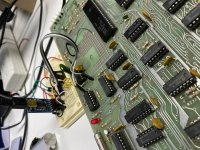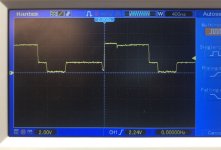mykrowyre
Experienced Member
Thanks those boards are a little pricey for a gamble.
I'll go with the 4k for now. Just waiting on the mail carrier.
I'll go with the 4k for now. Just waiting on the mail carrier.
| VCF West | Aug 01 - 02 2025, | CHM, Mountain View, CA |
| VCF Midwest | Sep 13 - 14 2025, | Schaumburg, IL |
| VCF Montreal | Jan 24 - 25, 2026, | RMC Saint Jean, Montreal, Canada |
| VCF SoCal | Feb 14 - 15, 2026, | Hotel Fera, Orange CA |
| VCF Southwest | June, 2025 | University of Texas at Dallas |
| VCF Southeast | June, 2025 | Atlanta, GA |
As Robbert notes, you need to press the spacebar to auto-detect the serial. Speed can be anywhere from 110 to 9600.
Here is a photo of my board if you want to compare jumpers. Just don't mock my soldering skills - I built it with a $10 Radio Shack soldering iron when I was 16 years old. I'm amazed it works at all! https://github.com/TomNisbet/Simple8085/blob/master/docs/explorer85.jpg
I did have trouble with the transistors that drive the RS232 blowing out. You may want to scope the lines on the other side of those. In fact, the last time I used it, I just connected one of those FTDI USB adapters right on the TTL side (possibly with some inverters) and used that to talk to it.
Robbert - I also have the 1.4 ROM but have done some mods to it. I'll PM you details.


If you are just debugging the base board (and I hope you are), then the only RAM present is the 255 bytes in the 8155. It might be useful to burn a new ROM just for debugging that does something really simple, like toggle the SOD line. That would verify that the 8085 and the 8755 are working.
That would also help verify that your EPROM programmer is really working. I didn't test the 8755 burner design beyond just burning a chip and running a checksum on it. Maybe pull the 8755, read it back, and compare the binaries just to be sure.
It's good that you don't have the other EPROM and RAM installed yet. Less to debug!
If you are just debugging the base board (and I hope you are), then the only RAM present is the 255 bytes in the 8155. It might be useful to burn a new ROM just for debugging that does something really simple, like toggle the SOD line. That would verify that the 8085 and the 8755 are working.
That would also help verify that your EPROM programmer is really working. I didn't test the 8755 burner design beyond just burning a chip and running a checksum on it. Maybe pull the 8755, read it back, and compare the binaries just to be sure.
It's good that you don't have the other EPROM and RAM installed yet. Less to debug!
You inspired my to drag my Explorer out of the box to power it up. Attached is a photo with the franken-RS-232 connection. It's just a FTDI connector with an inverter on the two data lines and then connected to the TTL side of the I/O. That gets all of the analog RS-232 stuff out of the way.
It booted to the monitor and connected at 2400 N81 after hitting the spacebar. Mine seems to be a bit flakey too. Sometimes, after reset, the LED comes on but it doesn't respond to the terminal. Once you have it hooked up, try reset then spacebar several times. Maybe it is behaving similarly. Once I do get a good boot, it seems solid. I have it running now, so if you want me to scope something out for comparison just let me know.
View attachment 60381View attachment 60382
Ok thanks for the help guys.. I'll be back after some digging around.

Do all the 0 volts look good? The high levels can have a lot of variation, depending on which chips are driving but the 0 level should always be solid. A lifting of the 0 could be an indication of contention.
I don't have a working machine with 8216s to compare with the temperature but I wouldn't be surprised if the did run warm, being early ttl buffer chips.
Dwight
